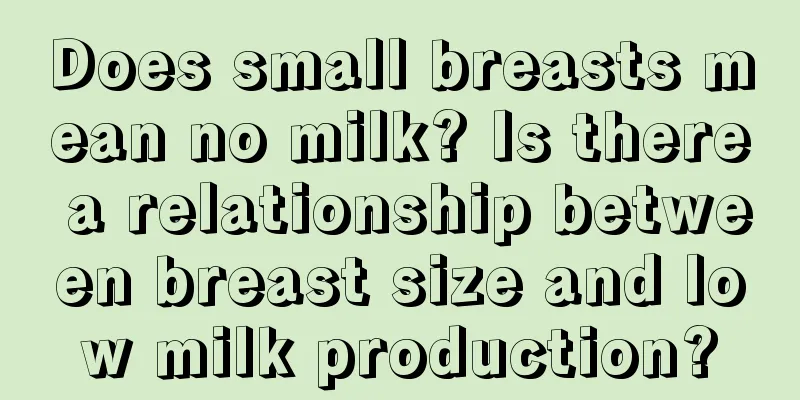Does small breasts mean no milk? Is there a relationship between breast size and low milk production?

|
Many mothers worry about not having enough milk when breastfeeding. Especially thin mothers worry that their breasts are not full enough and they cannot store enough milk. Today, let's talk about whether breast size is related to the amount of milk. Does breast size affect milk supply?1. Breast size has nothing to do with future milk production A person's body shape is largely related to genetics, nutrition and physical exercise. The same is true for the degree of breast development. Breast size refers to the amount of fat in the breast, and has nothing to do with the amount of milk in the future. Some people have large breasts, but the main structure is fat and connective tissue, there are not many breast cells, and the milk is not necessarily abundant. On the contrary, some people's breasts are not big before pregnancy, but when they are pregnant, they are stimulated by a large amount of estrogen and progesterone, and their breasts will grow rapidly. Most of the enlarged breast tissue is mammary tissue, and the milk is sufficient. So if the breasts are small now, don't worry, it will not affect the secretion of milk in the future. 2. Factors that affect milk secretion (1) Breast development: Whether or not there is milk secretion and the amount of milk produced after delivery are determined by whether the breasts are fully developed. Experts have shown that each breast, regardless of size, has dozens of lobules and millions of mammary gland alveoli. Therefore, all pregnant women have the ability to secrete milk. Some people have large breasts and poor mammary gland development, with not many glandular cells; some people have small breasts, but have many mammary glandular cells during lactation, which will suddenly increase in size and produce sufficient milk. (2) Breastfeeding time and feeding frequency: Some mothers have reduced milk secretion because they start breastfeeding too late or feed too little. Allowing the baby to suck the nipple irregularly and frequently as soon as possible after delivery is the driving force for stimulating milk secretion, and the number, intensity and duration of sucking are closely related to the amount of milk secretion. Milk is secreted while sucking, and the more you suck, the more you secrete. (3) Neurohumoral regulation: Some mothers are overly nervous and often in a state of anger, fear, sadness or worry, or are busy with housework and lack of sleep, which can reduce milk secretion. Therefore, in order to have sufficient milk, you must always stay happy and relaxed. The nervous state and body fluids are closely related. Only when the nerves are relaxed can the body fluids flow smoothly and the milk will naturally be sufficient. Big breasts give birth? Nonsense!To find out the specific reason whether breast size or smallness is directly proportional to the amount of milk produced, let us start from the physiological structure of the breast, that is, the four types of tissues that make up the breast, and understand the true appearance of the breast. The breasts are located in front of the pectoralis major muscles on both sides of the chest. Their position is related to age, body shape and degree of breast development. They include skin, subcutaneous fat and breast tissue. Breast tissue is composed of glands, ducts, adipose tissue and fibrous tissue, and has the function of secreting milk. The fibrous tissue is combined with the chest muscles to suspend the breasts to prevent them from sagging. The breasts are hung on the chest muscles by fibrous tissue, and the support of the chest muscles determines the direction of the breasts. The size of the breasts is determined by the amount of fat. The largest content in the breast is fat, and glandular tissue and fibrous tissue float in the adipose tissue. It can be seen that what determines the amount of milk secretion is not the size of the breasts, but the amount of breast tissue. Why is the baby's "granary" scarce when the mother has adequate nutrition? Modern women are well-developed due to adequate nutrition. However, once they give birth, they lack milk and can only breastfeed for a few months. This means that the "big granary" is constantly "empty". The reason for this is often caused by blocked mammary ducts. Why does the blockage of mammary ducts cause the loss of lactation function? What is the cause of the blockage? Many pregnant mothers did not expect that the bras they usually wear are the culprit. The detached materials on the bras are generally chemical fiber materials. Those invisible and intangible "hairs" are "unspeakable pain" for breast tissue. After these substances enter the glandular lobes through the mammary ducts, they stimulate the glandular cells, and the glandular cells will have a corresponding immune response to try to eliminate these foreign bodies. In this way, a big battle will occur in the glandular tissue. As a result, the glandular lobes of the glandular tissue are damaged, the glandular cells are destroyed, and the ability to secrete milk is lost. Finally, breast hyperplasia is formed, and even breast cancer can be caused. "Princess Taiping" also fought back against the waves and her "chest" was surging! Most Chinese women believe that breasts are natural and will develop as they are. No effort can improve them, and they do not need to be cared for or maintained regularly. In fact, God is fair to every woman, and pregnancy can also give the "Princess Taiping" a chance to have big breasts. Breast weight gain mainly occurs in the early stages of pregnancy, within 12 weeks. This is the result of the combined effects of prolactin hormone secreted by the pituitary gland and a variety of female hormones. Prolactin levels increase sharply in early pregnancy, promoting mammary gland cell proliferation and rapid growth of the glandular lobes to prepare for breastfeeding. Therefore, women with small breasts should seize the opportunity of secondary breast development within 12 weeks of pregnancy and take good care of their breasts to ensure that they can fully develop. We know that women gain weight after pregnancy. Ideally, pregnant mothers should gain weight during the entire pregnancy before the baby is born. Add 11 kg. Where does this 11 kg go? The baby's birth weight is 3.3 kg; the uterine muscle layer is 0.9 kg; the placenta is 0.6 kg; the breast is 0.4 kg; the blood volume is 1.2 kg; the body fluid is 2.6 kg; and the fat is 2.5 kg. During the breast development period during pregnancy, the average increase is 0.4 kg. Therefore, early pregnancy is the best time for secondary breast development. Expert opinion: In fact, breast changes begin in the first weeks of pregnancy (before birth). However, the mammary glands (glands that produce milk) are not fully functional until the lactation period begins. When the breasts swell during pregnancy, it is a sign that the mammary glands are about to work properly. The breast itself is a ladder, which is composed of several parts, including glandular tissue, connective tissue, blood, lymph, nerves and fat tissue. Fat tissue is the most important factor affecting breast size. The size of the breasts does not affect the amount and quality of milk a woman produces, of course, this should exclude the case of breast hypoplasia. in conclusion: The conclusion that "how big the breasts are, how much milk they produce" is not true! The editor once again reminds the majority of women who are preparing for pregnancy and during pregnancy that although big breasts have advantages, they must pay attention to avoid blockage of the milk ducts and wear underwear correctly; small breasts are not a bad thing, don't worry about not having milk because the cup size is too small! How to make more milkThe amount of milk has nothing to do with the size of the breasts! Many people believe that "big breasts produce more milk" because they think that bigger breasts have more space to store more milk. However, it is the mammary glands that determine milk secretion. The richer the mammary gland tissue, the more milk is secreted. It has no necessary relationship with the size of the breasts. It is not necessarily the case that big breasts have more glands and small breasts have fewer glands. Bigger breasts just have more fat. Of course, the secretion of milk is related to many factors. In addition to the requirement of abundant breast tissue and perfect glandular function, attention should also be paid to whether the mammary duct is unobstructed. The mammary duct is the channel for delivering milk. If the duct is unobstructed, the milk can flow out unimpeded and continuously. If the duct is not unblocked in time after delivery, the milk delivery will naturally be blocked. Over time, the secretion of milk will gradually decrease. Therefore, if you want sufficient milk, unblocking the ducts is also critical! In the first two days after giving birth, the mother's milk secretion is relatively small. The milk at this time is light yellow "colostrum", which is very precious to the baby. The mother should let the baby suck more. In addition to stimulating the breasts and making more milk, sucking more can also help the mother dredge the mammary ducts. In addition, some professional massage methods can also help to clear the ducts, especially when the ducts are blocked, you should ask a professional to help clear them as soon as possible to avoid mastitis. Don't worry, mom, the more you drink, the more milk you will have! In the first few days after delivery, some mothers feel that they have too little milk, so in order to let the baby have a full meal, they hurriedly add milk powder to the baby. Mothers who have this idea should note: before the baby is 6 months old, the more milk the baby eats, the more milk he will produce! So mothers should not be anxious, give the mammary glands some time. The mammary glands will gradually adjust the time and speed of milk secretion according to the baby's food intake to meet the baby's needs. |
<<: Reasons why babies hiccup Why do babies usually hiccup?
>>: What is egg freezing? How much does it cost?
Recommend
What is good to eat during confinement in winter? What soup is good to drink during confinement in winter?
During the confinement period, the mother's d...
Does the umbilical patch contain any medicinal ingredients? Will the umbilical patch cause allergies?
Umbilical cord stickers are a baby product that w...
9-year-old boy's schedule: study 18 hours a day
Recently, a news report reported the daily schedu...
Perfect tutorial to help your baby sleep well
Sleeping can change a person's appearance, do...
What does fetal heart rate monitoring look like? How to tell the gender of the fetus through fetal heart rate monitoring?
There are many popular sayings about how to tell ...
Will it be difficult to regain body shape after a normal birth? Can eating fish relieve depression during pregnancy?
Many people are hesitating between natural childb...
What is the smell of aromatherapy essential oil? Is aromatherapy essential oil harmful to the body?
Aromatherapy essential oils are products that we ...
How about Abbott's Pure Milk Powder? Is Abbott's Pure Milk Powder suitable for teenagers?
I heard that Abbott's PureZhi milk powder is ...
What are the main causes of dystocia? How to promote uterine recovery?
Many pregnant mothers tend to overthink what if t...
What is fetal toxin? What are the harms of fetal toxin?
Everyone must have heard of fetal toxicity in lif...
What is the reason for the yellow eye discharge in the newborn baby's eyes?
The newborn baby has a little yellow eye mucus in...
Is it okay for children to like eating meat?
Most parents are very happy to see their children...
What are the symptoms of female reproductive tract infection?
Women should develop good personal hygiene habits...
How can fat children lose weight? How can children who are very fat lose weight healthily?
Living conditions are getting better and better n...
How long does it take for children's teeth to fall out when they are loose? Which teeth should not be replaced when children are replaced?
It is a very normal phenomenon for children to re...









